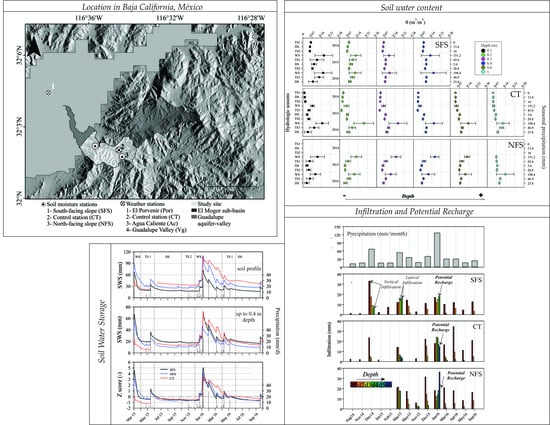Variations in Soil Water Content, Infiltration and Potential Recharge at Three Sites in a Mediterranean Mountainous Region of Baja California, Mexico
Abstract
:1. Introduction
2. Methods
2.1. Geographic and Climatic Setting
2.2. Site Description
2.3. Terrain Attributes
2.4. Site Instrumentation and Study Period
2.5. Soil Texture Analysis and Sensor Calibration
2.6. Soil Moisture Analyses
3. Results and Discussion
3.1. Precipitation Analyses
3.2. Terrain Attributes at the Study Sites
3.3. Temporal Variations of Soil Water Content with Depth
3.4. Comparison of Soil Water Storage Profiles Across Sites
3.5. Infiltration and Potential Recharge During Precipitation Events
4. Conclusions
- The evolution of soil water content showed a strong variability on the opposing hillslopes (SFS and NFS) principally in the winter and wet–dry transition seasons in the shallowest depths. Likewise, the hillslope sites exhibit a sudden increase in soil water content during P peaks followed by rapid depletion. In contrast, the flatter site (CT) showed slower soil water content decreases and the accumulation of water from upland areas during significant events. During high-intensity P events, sites with opposing aspects reveal an increase of soil water content at the soil–bedrock interface (~0.4 m in SFS; ~1 m in NFS) suggesting lateral subsurface fluxes, while vertical soil infiltration decreases noticeably, signifying the production of surface runoff.
- The seasonal patterns of SWS were similar at the three sites. Precipitation in winter (WS) and wet–dry transition months (TS1) replenish SWS at each location, which is depleted in the summer–fall months most notably at the hillslope sites. NFS and CT sites exhibit relatively high SWS due to their larger soil profile thickness, but SWS comparison until 0.4 m revealed higher values at SFS sites. This is attributed to the lack of vegetation cover, which permits additional water to reach the soil surface and infiltrate in vertical and horizontal directions, and the possible effect of lateral subsurface water transport from uphill locations at the soil–bedrock interface.
- The relation of SWS at hillslope sites showed strong positive correlation. Soil water storage was completely depleted in the soil profiles at hillslope sites after WS, meaning that there is no water available in the soil until the next WS. Water deficit occurred in summer months (DS) and dry–wet transition months (TS2) and lasted for nearly 70% of the study period at the three sites.
- Potential recharge occurred only in WS with P events greater than 50 mm/month at SFS site and greater than 120 mm/month at NFS site, indicating that soil depth and lack of vegetation cover play a critical role in the transport of water towards the soil–bedrock interface. We calculate that on average, around 9.5% of accumulated precipitation (~374 mm; from March 2015 to September 2016) could contribute to the recharge of the aquifer by the two sites with opposing aspects (~34.5 mm).
Author Contributions
Funding
Acknowledgments
Conflicts of Interest
References
- Ines, A.V.M.; Mohanty, B.P. Near-surface soil moisture assimilation for quantifying effective soil hydraulic propertis using generic algorithm: 1. Conceptual modeling. Water Resour. Res. 2008, 44, W06422. [Google Scholar] [CrossRef]
- Phuong Tran, A.; Bogaert, P.; Wiaux, F.; Vanclooster, M.; Lambot, S. High-resolution space-time quantification of soil moisture along a hillslope using joint analysis of ground penetrating radar and frequency domain reflectometry data. J. Hydrol. 2015, 523, 252–261. [Google Scholar] [CrossRef]
- Gomez-Plaza, A.; Alvarez-Rogel, J.; Albaladejo, J.; Castillo, V.M. Spatial patterns and temporal stability of soil moisture across a range of scales in a semi-arid environment. Hydrol. Process. 2000, 14, 1261–1277. [Google Scholar] [CrossRef]
- Martínez-Fernández, J.; Ceballos, A. Temporal stability of soil moisture in a large-field experiment in Spain. Soil Sci. Soc. Am. J. 2003, 67, 1647–1656. [Google Scholar] [CrossRef]
- Vivoni, E.R.; Rinehart, A.J.; Mendez-Barroso, L.A.; Aragon, C.A.; Bisht, G.; Cardenas, M.B.; Engle, E.; Forman, B.A.; Frisbee, M.D.; Gutierrez-Jurado, H.A.; et al. Vegetation controls on soil moisture distribution in the Valles Caldera, New Mexico, during the North American monsoon. Ecohydrology 2008, 1, 225–238. [Google Scholar] [CrossRef]
- Anenkhonov, O.A.; Korolyuk, A.Y.; Sandanov, D.V.; Liu, H.; Zverev, A.A.; Guo, D. Soil-moisture conditions indicated by field-layer plants help identify vulnerable forests in the forest-steppe of semi-arid Southern Siberia. Ecol. Indic. 2015, 57, 196–207. [Google Scholar] [CrossRef] [Green Version]
- Zhang, T.; Berndtsson, R. Temporal patterns and spatial scale of soil water variability in a small humid catchment. J. Hydrol. 1988, 104, 111–128. [Google Scholar] [CrossRef]
- Cantón, Y.; Solé-Benet, A.; Domingo, F. Temporal and spatial patterns of soil moisture in semiarid badlands of SE Spain. J. Hydrol. 2004, 285, 199–214. [Google Scholar] [CrossRef]
- Cleverly, J.; Eamus, D.; Restrepo Coupe, N.; Chen, C.; Maes, W.; Li, L.; Faux, R.; Santini, S.N.; Rumman, R.; Yu, Q.; et al. Soil moisture controls on phenology and productivity in semi-arid critical zone. Sci. Total Environ. 2016, 568, 1227–1237. [Google Scholar] [CrossRef]
- Zhao, Y.; Peth, S.; Wang, X.Y.; Lin, H.; Horn, R. Controls of surface soil moisture spatial patterns and their temporal stability in a semi-arid steppe. Hydrol. Process. 2010, 24, 2507–2519. [Google Scholar] [CrossRef]
- Choi, M.; Jacobs, J.M. Soil moisture variability of root zone profiles within SMEX02 remote sensing footprints. Adv. Water Resour. 2007, 30, 883–896. [Google Scholar] [CrossRef]
- Gao, L.; Shao, M.; Peng, X.; She, D. Spatio-temporal variability and temporal stability of water contents distributed within soil profiles at a hillslope scale. Catena 2015, 132, 29–36. [Google Scholar] [CrossRef] [Green Version]
- Zhou, J.; Fu, B.; Gao, G.; Lü, N.; Lü, Y.; Wang, S. Temporal stability of surface soil moisture of different vegetation types in the Loess Plateau of China. Catena 2015, 128, 1–15. [Google Scholar] [CrossRef] [Green Version]
- Porporato, A.; Laio, F.; Ridolfi, L.; Rodriguez-Iturbe, I. Plants in water-controlled ecosystems: Active role in hydrologic processes and response to water stress: III. Vegetation water stress. Adv. Water Resour. 2001, 24, 725–744. [Google Scholar] [CrossRef]
- Legates, D.R.; Mahmood, R.; Levia, D.F.; DeLiberty, T.L.; Quiring, S.M.; Houser, C.; Nelson, F.E. Soil moisture: A central and unifying theme in physical geography. Prog. Phys. Geogr. 2011, 35, 65–86. [Google Scholar] [CrossRef]
- Yang, L.; Wei, W.; Chen, L.; Chen, W.; Wang, J. Response of temporal variation of soil moisture to vegetation restoration in semi-arid Loess Plateau, China. Catena 2014, 115, 123–133. [Google Scholar] [CrossRef] [Green Version]
- Reynolds, J.F.; Kemp, P.R.; Ogle, K.; Fernández, R.J. Modifying the pulse-reserve paradigm for deserts of North America: Precipitation pulses, soil water and plant responses. Oecología 2004, 141, 194–210. [Google Scholar] [CrossRef]
- Vivoni, E.R.; Gutiérrez-Jurado, H.A.; Aragón, C.A.; Méndez-Barroso, L.A.; Rinehart, A.J.; Wyckoff, R.L.; Rodríguez, J.C.; Watts, C.J.; Bolten, J.D.; Lakshmi, V.; et al. Variation of hydrometeorological conditions along a topographic transect in northwestern Mexico during the North American monsoon. J. Clim. 2007, 20, 1792–1809. [Google Scholar] [CrossRef]
- Del Toro-Guerrero, F.J.; Kretzschmar, T.; Hinojosa-Corona, A. Hydric balance in a semi-arid basin, El Mogor, Baja California, Mexico. Technol. Water Sci. 2014, 5, 69–81. (In Spanish) [Google Scholar]
- Foster, S.S.D.; Smith-Carington, A. The interpretation of tritium in the chalk unsaturated zone. J. Hydrol. 1980, 46, 343–364. [Google Scholar] [CrossRef]
- Phillips, F.M. Environmental tracers for water movement in desert soils of the American Southwest. Soil Sci. Soc. Am. J. 1994, 58, 15–24. [Google Scholar] [CrossRef]
- Izbicki, J.A.; Radyk, J.; Michel, R.L. Water movement through a thick unsaturated zone underlying an intermittent stream in the western Mojave Desert, Southern California, USA. J. Hydrol. 2000, 238, 194–217. [Google Scholar] [CrossRef]
- Walvoord, M.A.; Plummer, M.A.; Phillips, F.M. Deep arid system hydrodynamics 1. Equilibrium states and response times in thick desert vadose zones. Water Resour. Res. 2002, 38, 1–15. [Google Scholar] [CrossRef]
- Wilson, J.L.; Guan, H. Mountain-Block hydrology and Mountain-Front recharge. In Groundwater Recharge in a Desert Environment: The Southwestern United States; Phillips, F.M., Hogan, J., Scanlon, B., Eds.; AGU: Washington, DC, USA, 2004; pp. 113–138. [Google Scholar]
- Gutiérrez-Jurado, H.A.; Vivoni, E.R.; Harrison, J.B.J.; Guan, H. Ecohydrology of root zone water fluxes and soil development in complex semiarid rangelands. Hydrol. Processes 2006, 20, 3289–3316. [Google Scholar] [CrossRef]
- Gutiérrez-Jurado, H.A.; Vivoni, E.R.; Cikoski, C.; Harrison, J.B.J.; Bras, R.L.; Istanbulluoglu, E. On the observed ecohydrologic dynamics of a semiarid basin with aspect-delimited ecosystems. Water Resour. Res. 2013, 49, 8263–8284. [Google Scholar] [CrossRef] [Green Version]
- Bennie, J.; Hill, M.O.; Baxter, R.; Huntley, B. Influence of slope aspect on long-term vegetation change in British chalk grasslands. J. Ecol. 2006, 94, 355–368. [Google Scholar] [CrossRef]
- Warren, R.J. An experimental test of well-described vegetation patterns across slope aspects using woodland herb transplants and manipulated abiotic drivers. New Phytol. 2010, 185, 1038–1049. [Google Scholar] [CrossRef] [Green Version]
- Dubayah, R.; Rich, P.M. GIS-based solar radiation modeling. In GIS and Environmental Modeling: Progress and Research Issues; Goodchild, M.F., Steyaert, L.T., Parks, B.O., Johnston, C., Maidment, D., Crane, M., Glendinning, S., Eds.; GIS World Books: Fort Collins, CO, USA, 1996; pp. 129–137. [Google Scholar]
- Bennie, J.; Huntley, B.; Wiltshire, A.O.; Hill, M.; Baxter, R. Slope, aspect and climate: Spatially explicit and implicit models of topographic microclimate in chalk grassland. Ecol. Model. 2008, 216, 47–59. [Google Scholar] [CrossRef]
- Albaba, I. The effects of slope orientations on vegetation characteristics of Wadi Alquf forest reserve (WAFR) West Bank-Palestine. Int. J. Agric. Soil Sci. 2014, 2, 118–125. [Google Scholar]
- Del Toro-Guerrero, F.J.; Hinojosa-Corona, A.; Kretzschmar, T. A comparative study of NDVI values between North-and South-Facing slopes in a semiarid mountainous region. IEEE J. Sel. Top. Appl. Earth Obs. Remote Sens. 2016, 9, 5350–5356. [Google Scholar] [CrossRef]
- Kurczyn-Robledo, A.; Kretzschmar, T.; Hinojosa-Corona, A. Surface runoff evaluation in the northwest of Guadalupe Valley, B.C., México, using the numbered curves method and satellite data. Rev. Mex. Cienc. Geol. 2007, 24, 1–14. (In Spanish) [Google Scholar]
- Del Toro-Guerrero, F.J.; Kretzschmar, T. Identifying periods of historical drought in a region of semiarid mediterranean climate type. Rev. Mex. Cienc. Agríc. 2016, 7, 1311–1320. [Google Scholar] [CrossRef]
- Flores-Zavala, R. Evaporación y Transpiración Según tres Patrones Espaciales y Estacionales en un Ecosistema Mediterráneo en la Subcuenca de El Mogor, Ensenada, Baja California. Tesis de Maestría, Centro de Investigación Científica y de Educación Superior de Ensenada, Baja California (CICESE), Ensenada, Mexico, 2016; p. 36. [Google Scholar]
- Villarreal, S.; Vargas, R.; Yepez, E.A.; Acosta, J.S.; Castro, A.; Escoto-Rodriguez, M.; Lopez, E.; Martínez-Osuna, J.; Rodriguez, J.C.; Smith, S.V.; et al. Contrasting precipitation seasonality influences evapotranspiration dynamics in water-limited shrublands. J. Geophys. Res. Biogeosci. 2016, 121, 494–508. [Google Scholar] [CrossRef]
- Pražnikar, J. Particulate matter time-series and Köppen-Geiger climate classes in North America and Europe. Atmos. Environ. 2017, 150, 136–145. [Google Scholar] [CrossRef]
- Castro-Escárrega, J.J.; Terán-Martínez, G.E.; Siqueiros-López, C. Geological-Mining Chart Tijuana I11-11 Baja California. Mexican Geological Service. 2003. Available online: http://www.sgm.gob.mx (accessed on 12 June 2018).
- Mexican National Institute of Statistics and Geography (INEGI). High Resolution Digital Elevation Model LiDAR, Terrain Type; I11D82XX (Data and Metadata); INEGI: Baja California, Mexico, 2008. [Google Scholar]
- Beven, K.J.; Kirkby, M. A physical based variable contributing area model of basin hydrology. Hydrol. Sci. Bull. 1979, 24, 43–79. [Google Scholar] [CrossRef]
- International Atomic Energy Agency (IAEA). Field Estimation of Soil Water Content; IAEA: Vienna, Austria, 2008; p. 131. [Google Scholar]
- Qi, Z.; Helmers, M.J. The conversion of permittivity as measured by a PR2 capacitance probe into soil moisture values for Des Moines lobe soils in Iowa. Soil Use Manag. 2010, 26, 82–92. [Google Scholar] [CrossRef]
- Kargas, G.; Kerkides, P.; Pouovassilis, A. Infiltration of rain water in semi-arid areas under three land surface treatments. Soil Tillage Res. 2012, 120, 15–24. [Google Scholar] [CrossRef]
- Delta T-Devices, Ltd. User Manual for the Profile Probe Type PR2; Delta T-Devices, Ltd.: Cambridge, UK, 2016. [Google Scholar]
- Green, W.H.; Ampt, G.A. Studies in soil physics. I. The flow of air and water through soils. J. Agric. Sci. 1911, 4, 1–24. [Google Scholar] [CrossRef]
- Bhark, E.W.; Small, E.E. Association between plant canopies and the spatial patterns of infiltration in shrubland and grassland of the Chihuahuan Desert, New Mexico. Ecosystems 2003, 6, 185–196. [Google Scholar] [CrossRef]
- Moran, M.S.; Hamerlynck, E.P.; Scott, R.L.; Stone, J.J.; Holifield Collins, C.D.; Keefer, T.O.; Bryant, R.; DeYoung, L.; Nearing, G.S.; Sugg, Z.; et al. Hydrologic response to precipitation pulses under and between shrubs in the Chihuahuan Desert, Arizona. Water Resour. Res. 2010, 46, 1–12. [Google Scholar] [CrossRef]
- Zakharov, S.A. Importance of slope aspect and gradient for soil and vegetation distribution in the Great Caucasus. Bot. J. Acad. Sci. USSR 1940, 25, 378–405. [Google Scholar]
- Florinsky, I.V. Digital Terrain Analysis in Soil Science and Geology, 2nd ed.; Academic Press-Elsevier: London, UK, 2016; p. 486. [Google Scholar]
- Willgoose, G.; Hancock, G. Revisiting the hypsometric curve as an indicator of form and process in transport-limited catchment. Earth Surf. Process. Landf. 1998, 23, 611–623. [Google Scholar] [CrossRef]
- Kirkby, M.J.; Chorley, R.J. Throughflow, overland flow and erosion. Bull. Int. Assoc. Sci. Hydrol. 1967, 12, 5–21. [Google Scholar] [CrossRef]
- Hu, W.; Shao, M.A.; Reichardt, K. Using a new criterion to identify sites for mean soil water storage evaluation. Soil Sci. Soc. Am. J. 2010, 74, 762–773. [Google Scholar] [CrossRef]
- Gao, L.; Shao, M. Temporal stability of soil water storage in diverse soil layers. Catena 2012, 95, 24–32. [Google Scholar] [CrossRef]
- Penna, D.; Brocca, L.; Borga, M.; Dalla Fontana, G. Soil moisture temporal stability at different depths on two alpine hillslopes during wet and dry periods. J. Hydrol. 2013, 477, 55–71. [Google Scholar] [CrossRef]
- Gutiérrez-Jurado, H.A.; Vivoni, E.R.; Istanbulluoglu, E.; Bras, R.L. Ecohydrological response to a geomorphically significant flood event in a semiarid catchment with contrasting ecosystems. Geophys. Res. Lett. 2007, 34, L24S25. [Google Scholar] [CrossRef]
- Rosenbaum, U.; Bogena, H.R.; Herbst, M.; Huisman, J.A.; Peterson, T.J.; Weuthen, A.; Western, A.W.; Vereecken, H. Seasonal and event dynamics of spatial soil moisture patterns at the small catchment scale. Water Resour. Res. 2012, 48, 1–22. [Google Scholar] [CrossRef]
- Jia, X.; Shao, M.; Wei, X.; Wang, Y. Hillslope scale temporal stability of soil water storage in diverse soil layers. J. Hydrol. 2013, 498, 254–264. [Google Scholar] [CrossRef]
- McIntosh, J.; McDonnell, J.J.; Peters, N.E. Tracer and hydrometric study of preferential flow in large undisturbed soil cores from the Georgia Piedmont, USA. Hydrol. Process. 1999, 13, 139–155. [Google Scholar] [CrossRef]
- Lin, H.; Zhou, X. Evidence of subsurface preferential flow using soil hydrologic monitoring in the Shale Hills catchment. Eur. J. Soil Sci. 2008, 59, 34–49. [Google Scholar] [CrossRef]
- Takagi, K.; Lin, H.S. Changing controls of soil moisture spatial organization in the Shale Hills Catchment. Geoderma 2012, 173–174, 289–302. [Google Scholar] [CrossRef]
- Famiglietti, J.S.; Rudnicki, J.W.; Rodell, M. Variability in surface moisture content along a hillslope transect: Rattlesnake Hill, Texas. J. Hydrol. 1998, 210, 259–281. [Google Scholar] [CrossRef] [Green Version]
- Brocca, L.; Morbidelli, R.; Melone, F.; Moramarco, T. Soil moisture spatial variability in experimental areas of central Italy. J. Hydrol. 2007, 333, 356–373. [Google Scholar] [CrossRef]
- Moeslund, J.E.; Arge, L.; Bocher, P.K.; Dalgaard, T.; Odgaard, M.V.; Nygaard, B.; Svenning, J. Topographically controlled soil moisture is the primary driver of local vegetation patterns across a lowland region. Ecosphere 2013, 4, 91. [Google Scholar] [CrossRef]
- Ceballos, A.; Martínez-Fernández, J.; Santos, F.; Alonso, P. Soil-water behavior of sandy soils under semi-arid conditions in the Duero Basin (Spain). J. Arid Environ. 2002, 51, 501–519. [Google Scholar] [CrossRef]
- Grayson, R.B.; Western, A.W.; Chiew, H.S.; Blöschl, G. Preferred states in spatial soil moisture patterns: Local and nonlocal controls. Water Resour. Res. 1997, 33, 2808–2897. [Google Scholar] [CrossRef]


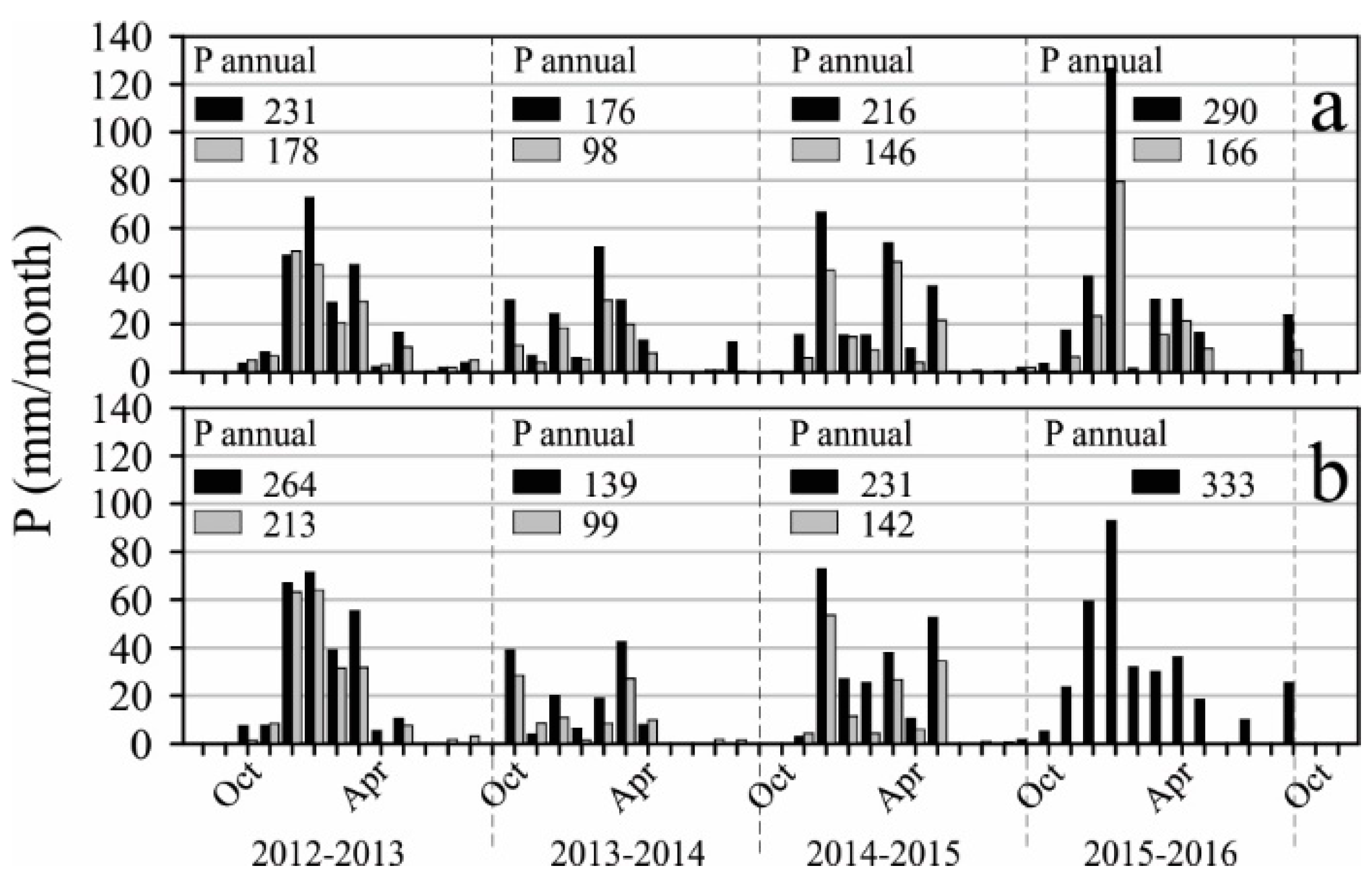
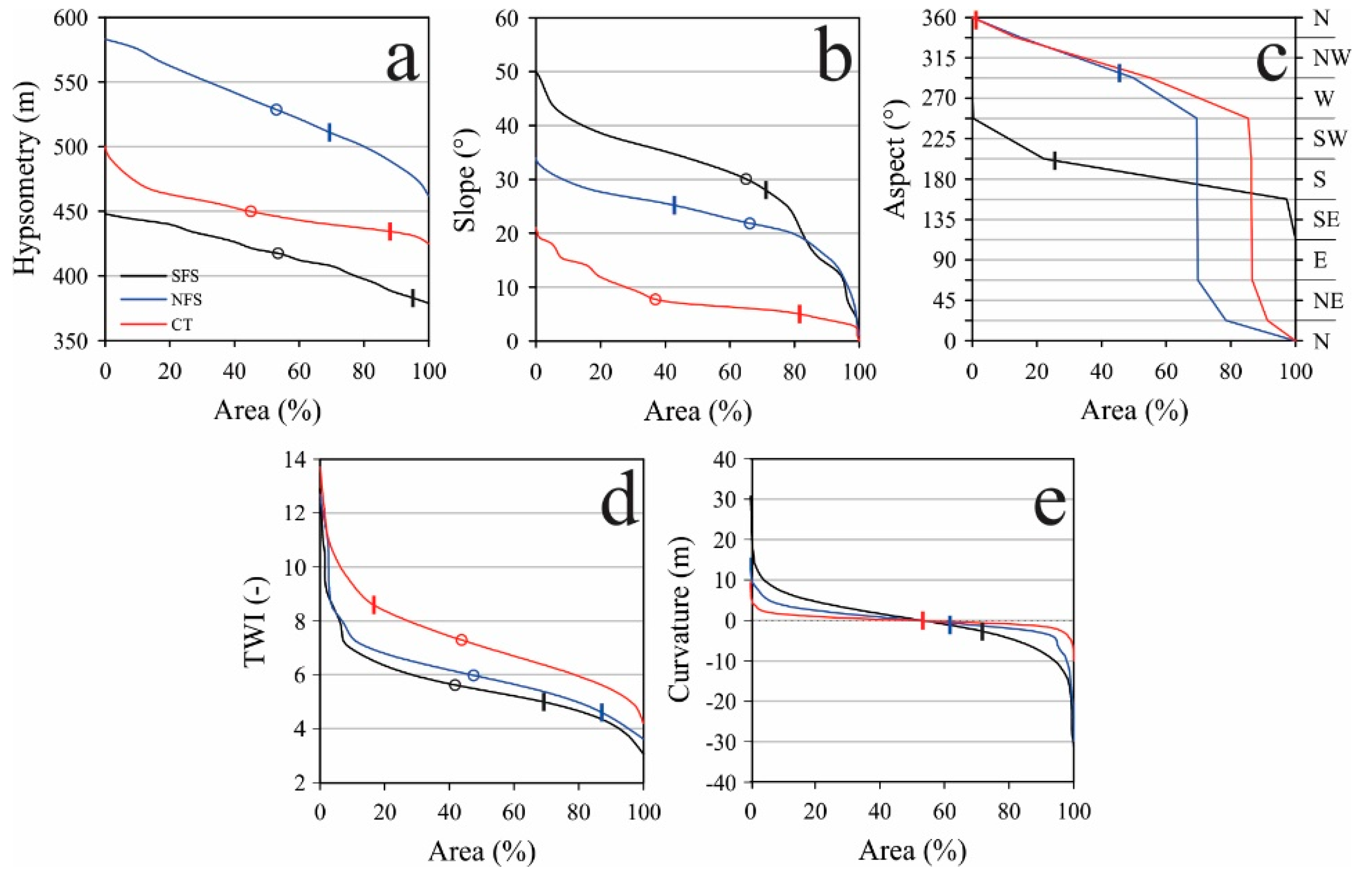


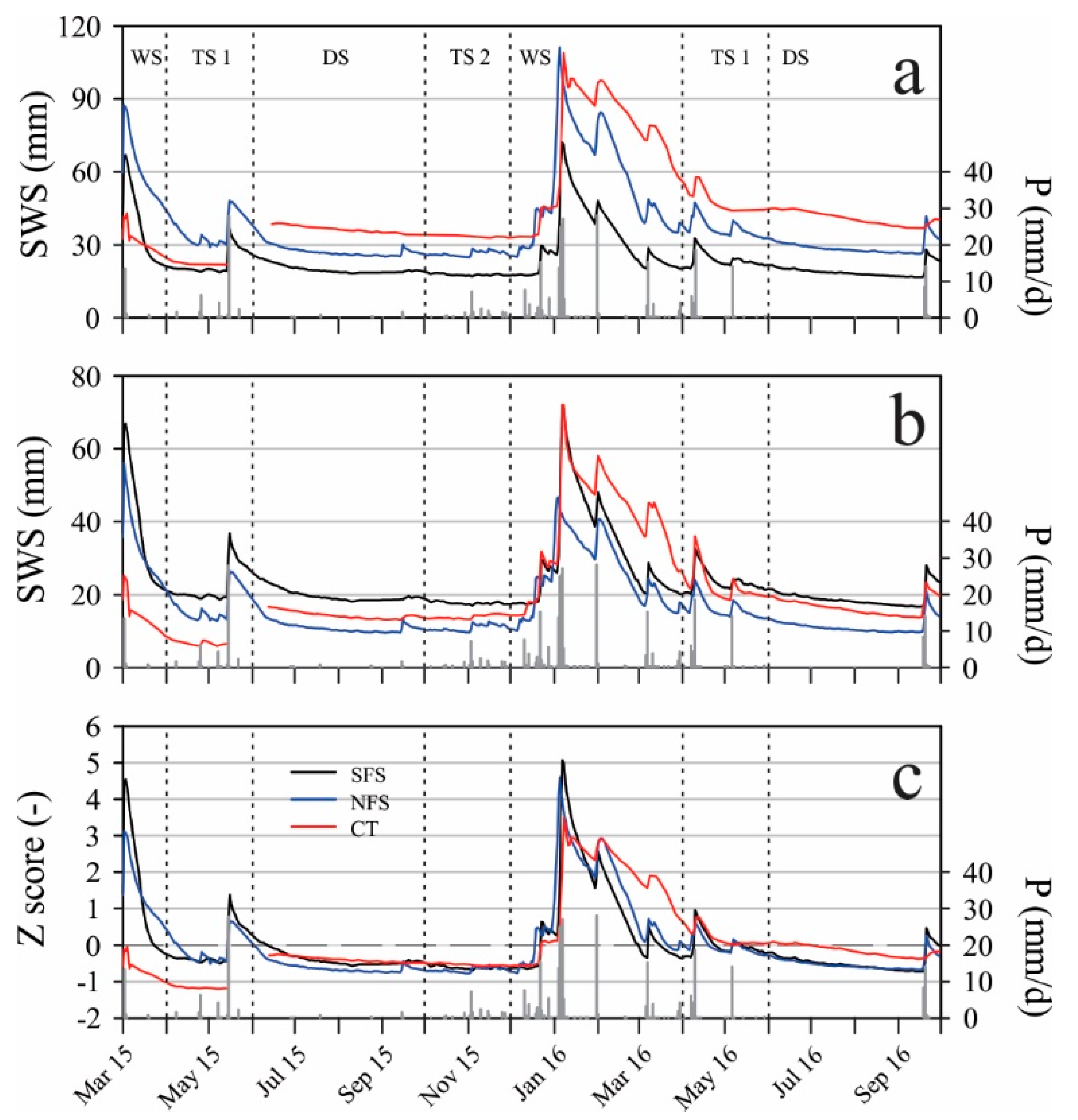
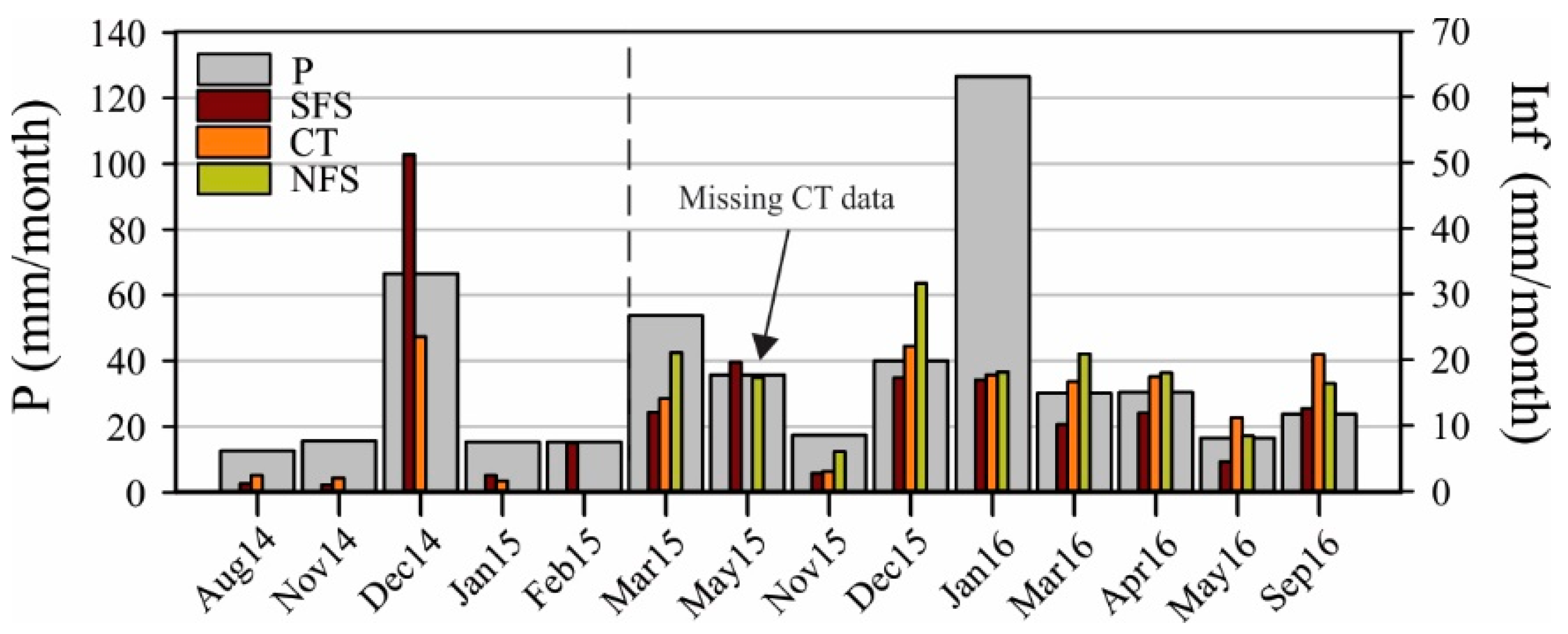
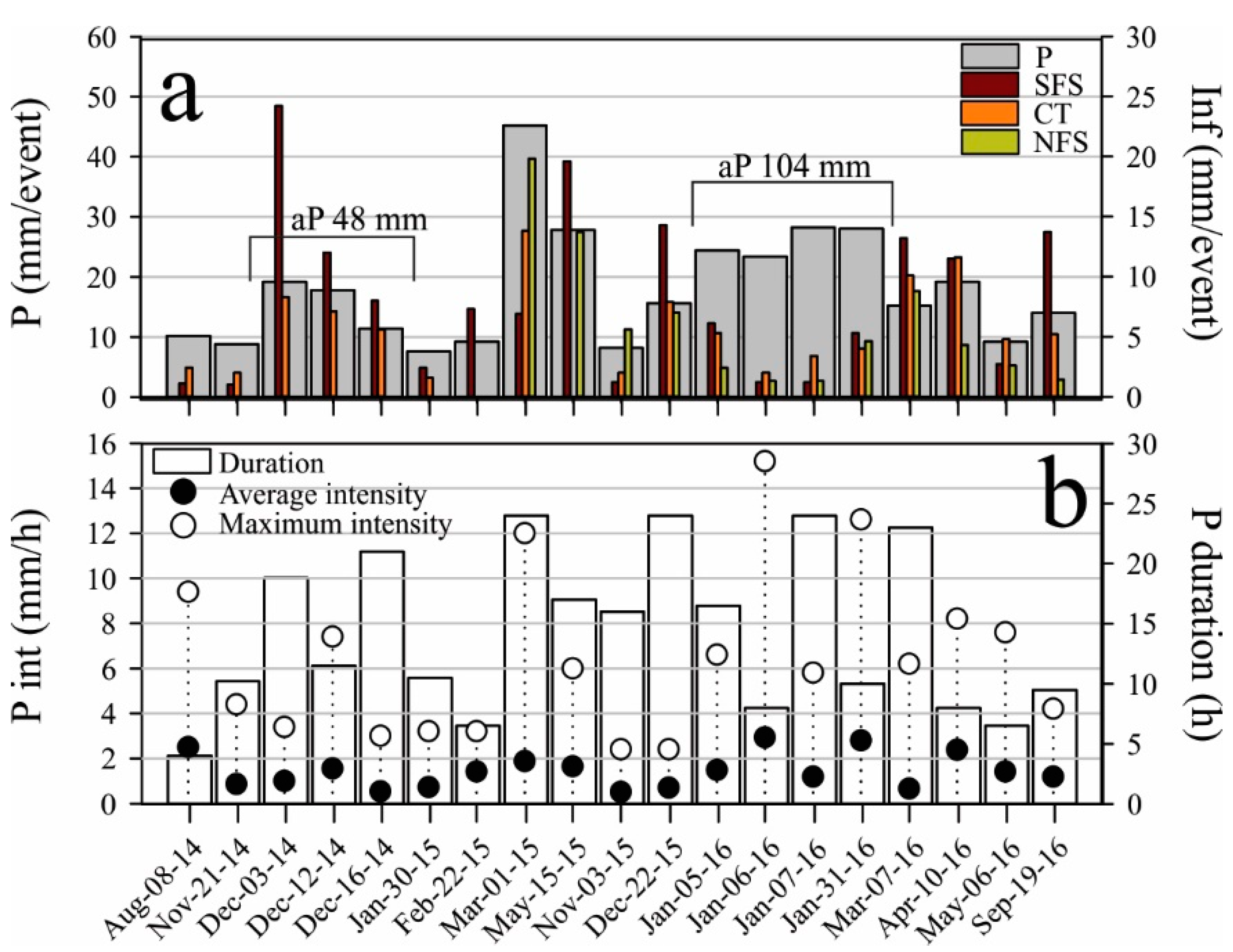

| Site | Depth (m) | ρb (g/cm3) | µ (%) | Sand (%) | Silt (%) | Clay (%) | Texture |
|---|---|---|---|---|---|---|---|
| SFS | 0.1 | 1.51 | 43 | 89 | 10 | 1 | fine sand |
| 0.2 | 1.56 | 41 | 89 | 10 | 1 | fine sand | |
| 0.3 | 1.56 | 41 | 90 | 9 | 1 | fine sand | |
| 0.4 | 1.71 | 36 | 89 | 10 | 1 | fine sand | |
| CT | 0.1 | 1.51 | 43 | 84 | 14 | 2 | loamy fine sand |
| 0.2 | 1.61 | 39 | 85 | 13 | 2 | loamy fine sand | |
| 0.3 | 1.56 | 41 | 85 | 13 | 2 | loamy fine sand | |
| 0.4 | 1.56 | 41 | 83 | 14 | 3 | loamy fine sand | |
| 0.6 | 1.71 | 36 | 87 | 11 | 2 | fine sand | |
| 1 | 1.52 | 43 | 64 | 2 | 34 | sandy clay loam | |
| NFS | 0.1 | 1.46 | 45 | 85 | 13 | 2 | loamy fine sand |
| 0.2 | 1.41 | 47 | 91 | 7 | 2 | fine sand | |
| 0.3 | 1.36 | 49 | 92 | 6 | 2 | fine sand | |
| 0.4 | 1.51 | 43 | 94 | 5 | 1 | fine sand | |
| 0.6 | 1.61 | 39 | 93 | 6 | 1 | fine sand | |
| 1 | 1.56 | 41 | 95 | 4 | 1 | fine sand |
| Stats | Site | WS-15 | TS1-15 | DS-15 | TS2-15 | WS-16 | TS1-16 | DS-16 | Avg Total |
|---|---|---|---|---|---|---|---|---|---|
| Min | SFS | 21 | 19 | 18 | 17 | 17 | 20 | 17 | 18 |
| NFS | 45 | 29 | 25 | 25 | 25 | 33 | 26 | 30 | |
| CT | 25 | 21 | 32 | 33 | 33 | 44 | 36 | 32 | |
| Max | SFS | 67 | 37 | 26 | 19 | 72 | 33 | 28 | 40 |
| NFS | 87 | 48 | 38 | 29 | 111 | 47 | 41 | 57 | |
| CT | 43 | 32 | 39 | 34 | 109 | 59 | 45 | 51 | |
| Avg | SFS | 37 | 23 | 20 | 18 | 32 | 24 | 19 | 25 |
| NFS | 61 | 36 | 28 | 26 | 56 | 37 | 29 | 39 | |
| CT | 31 | 23 | 36 | 34 | 70 | 48 | 41 | 40 |
| Stats | Site | WS-15 | TS1-15 | DS-15 | TS2-15 | WS-16 | TS1-16 | DS-16 | Avg Total |
|---|---|---|---|---|---|---|---|---|---|
| Min | SFS | 21 | 19 | 18 | 17 | 17 | 20 | 17 | 18 |
| NFS | 22 | 13 | 10 | 10 | 10 | 13 | 10 | 13 | |
| CT | 9 | 6 | 13 | 13 | 14 | 18 | 14 | 12 | |
| Max | SFS | 67 | 37 | 26 | 19 | 72 | 33 | 28 | 40 |
| NFS | 56 | 26 | 18 | 13 | 47 | 24 | 21 | 29 | |
| CT | 25 | 13 | 17 | 15 | 72 | 36 | 23 | 29 | |
| Avg | SFS | 37 | 23 | 20 | 18 | 32 | 24 | 19 | 25 |
| NFS | 33 | 17 | 11 | 11 | 26 | 16 | 11 | 18 | |
| CT | 14 | 8 | 14 | 14 | 39 | 22 | 16 | 18 |
© 2018 by the authors. Licensee MDPI, Basel, Switzerland. This article is an open access article distributed under the terms and conditions of the Creative Commons Attribution (CC BY) license (http://creativecommons.org/licenses/by/4.0/).
Share and Cite
Del Toro-Guerrero, F.J.; Vivoni, E.R.; Kretzschmar, T.; Bullock Runquist, S.H.; Vázquez-González, R. Variations in Soil Water Content, Infiltration and Potential Recharge at Three Sites in a Mediterranean Mountainous Region of Baja California, Mexico. Water 2018, 10, 1844. https://doi.org/10.3390/w10121844
Del Toro-Guerrero FJ, Vivoni ER, Kretzschmar T, Bullock Runquist SH, Vázquez-González R. Variations in Soil Water Content, Infiltration and Potential Recharge at Three Sites in a Mediterranean Mountainous Region of Baja California, Mexico. Water. 2018; 10(12):1844. https://doi.org/10.3390/w10121844
Chicago/Turabian StyleDel Toro-Guerrero, Francisco José, Enrique R. Vivoni, Thomas Kretzschmar, Stephen Holmes Bullock Runquist, and Rogelio Vázquez-González. 2018. "Variations in Soil Water Content, Infiltration and Potential Recharge at Three Sites in a Mediterranean Mountainous Region of Baja California, Mexico" Water 10, no. 12: 1844. https://doi.org/10.3390/w10121844





